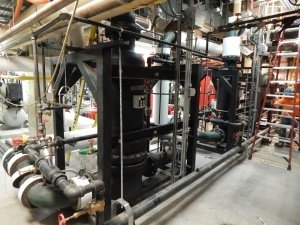Deep in the basement of a newly refurbished building on the campus of Baltimore’s largest hospital, among the loud whizzes, buzzes and bangs of the building’s mechanical systems, a team of engineers eagerly looked on as the chamber of the newly installed building heat system began to fill with steam. They were there to monitor the first start-up in the Baltimore/Washington area of Maxi-Therm’s revolutionary vertical flooded heat exchanger. Once the new system was up and running and the old system was taken off line, everybody noticed something strange – all the whizzes, buzzes and bangs were gone. The Maxi-Therm  system was fully functioning and wasn’t loud enough to even disturb a whisper.
system was fully functioning and wasn’t loud enough to even disturb a whisper.
More than a year before, the hospital’s team, along with their engineering partners out of Philadelphia, chose the award-winning Maxi-Therm steam-to-liquid heat exchanger  as their basis of design. Right from the start they were excited about the concept with its extensive install base in the United States, +/-2⁰F of set point temperature guarantee, 200⁰F subcooled condensate, reduced installation cost and ability to use high pressure steam without needing a PRV station. But in the end, what convinced them to go with Maxi-Therm was the 9.7% in energy savings derived from the system’s use of both the latent and sensible heat of steam to heat the liquid. Skeptical at first, it didn’t take long for the mechanical contractor to get on board either. The installation was simple, requiring minimal connections – liquid in, liquid out, steam in, condensate out and electrical – saving them both time and money.
as their basis of design. Right from the start they were excited about the concept with its extensive install base in the United States, +/-2⁰F of set point temperature guarantee, 200⁰F subcooled condensate, reduced installation cost and ability to use high pressure steam without needing a PRV station. But in the end, what convinced them to go with Maxi-Therm was the 9.7% in energy savings derived from the system’s use of both the latent and sensible heat of steam to heat the liquid. Skeptical at first, it didn’t take long for the mechanical contractor to get on board either. The installation was simple, requiring minimal connections – liquid in, liquid out, steam in, condensate out and electrical – saving them both time and money.
An undeniable success, Jobe Industrial is looking forward to the rapid adoption of Maxi-Therm in the Mid-Atlantic region since it is now the basis of design for several forthcoming projects in the area. Please contact Jobe Industrial to learn more about the Maxi-Therm concept and the savings it can provide on your next project.


